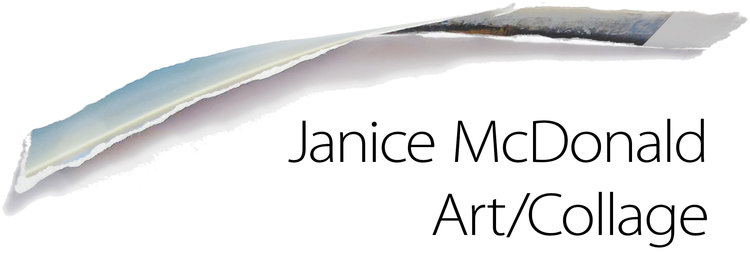I’ve written about the other series of collage works that were shown at the Arvada Center’s COllage exhibition in a previous post… this one introduces the display of my collage diary project. I was thrilled to have all of the diaries on display except the 2025 volume that I’m currently working with. I was also able to project a video that incudes scanned images of every collage from the 2024 diary, in sequence, and opens with a view of my desk as I work on a single day's collage in the 2025 diary. This video was projected continually in a custom viewing niche as part of the COllage exhibition at the Arvada Center (Arvada, Colorado) in fall 2025. The exhibition featured a sound collage nearby so this nearly 10 minute video does not have any audio... feel free to use your own soundtrack :)
Images below are of the viewing niche… and to give some context to the way the gallery was laid out. You can see glimpses of other artists’ work through the openings and in the distance.
Below is the story/statement that accompanied this work:
One year during the holidays I was given a small page-a-day diary. Somehow April 1 arrived and I noticed the little book shoved to the back of my desk, still empty. I thought it might be an interesting place to work with some of the small scraps of paper that accumulate in my studio — I work with recycled bits of everyday printed materials, including fragments of junk mail and household packaging.
I didn’t think of it as an ongoing project when I began (in 2019), however I pretty immediately realized that working in the diary on a daily basis was fun and transformational so I've continued ever since.
The collages aren’t planned in advance — I just find an interesting paper fragment, glue it down, and then build a composition by adding one piece at a time. I often challenge myself to begin with an odd shape or color. Some compositions are better than others — I’ve realized that it’s the continuing exploration that is most important. Sometimes the least visually successful attempts actually teach me more than the collages that come together easily.
The diaries during the exhibition installation process, before the acrylic case was added.
I usually spent 15-30 minutes working on a collage during a simple, wrapping-up-the-day process. My criteria is to work on each dated page sometime during that actual day. This daily practice has become a personal ritual of sorts, a quiet and meditative time.
Each day when I’m done, I take a photo and post the composition to my Instagram story. What you see here is a projection of all 365 collages made in 2024 and nearby all the completed diaries are also on display.
This ongoing practice provides a real sense of creative momentum that carries over into other projects in the studio. I can see a personal symbology and new visual language developing over time.
I’m also regularly reminded, by the growing girth of the diary over the course of each year, that all the little efforts we make in life really do add up when repeated over time.
NOTE: Thanks to Jim Leggitt for help with the unwieldy diary scanning process, Collin Parson for working with me on the idea to present a year’s worth of images, Collin Sanders for editing / putting it all together, and the Arvada Center crew for their installation expertise. Video ©2025, Janice McDonald.
More information on the Collage Diary/Momentum project:
—Many who discovered my daily practice online have had questions about the book, materials, etc… I’ve written about all of that on my blog.
—I was interviewed by author Kelly McMasters about my collage diary process / project in September 2025. I’m definitely not your typical diarist, so I was particularly honored to have my visual diary featured in her “Show Me Your Diary” project.
—A January 2024 article in The Times (London) also features the collage diary.

































